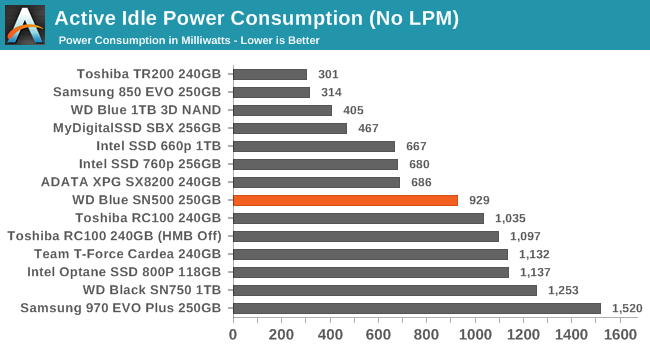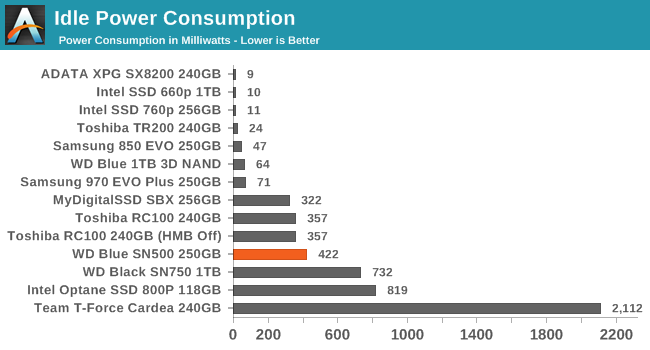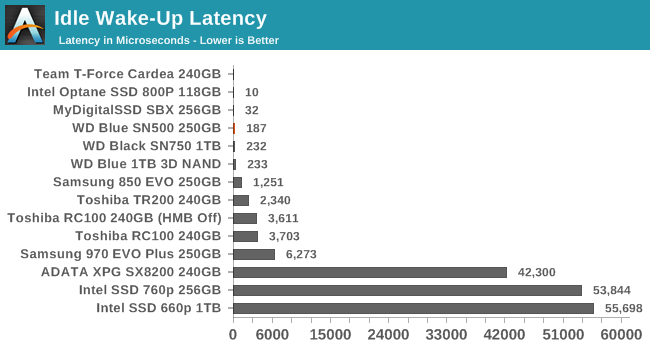The Western Digital WD Blue SN500 SSD Review: Moving The Mainstream To NVMe
by Billy Tallis on April 19, 2019 9:30 AM ESTPower Management Features
Real-world client storage workloads leave SSDs idle most of the time, so the active power measurements presented earlier in this review only account for a small part of what determines a drive's suitability for battery-powered use. Especially under light use, the power efficiency of a SSD is determined mostly be how well it can save power when idle.
For many NVMe SSDs, the closely related matter of thermal management can also be important. M.2 SSDs can concentrate a lot of power in a very small space. They may also be used in locations with high ambient temperatures and poor cooling, such as tucked under a GPU on a desktop motherboard, or in a poorly-ventilated notebook.
| WD Blue SN500 NVMe Power and Thermal Management Features |
|||
| Controller | Western Digital in-house | ||
| Firmware | 201000WD | ||
| NVMe Version |
Feature | Status | |
| 1.0 | Number of operational (active) power states | 3 | |
| 1.1 | Number of non-operational (idle) power states | 2 | |
| Autonomous Power State Transition (APST) | Supported | ||
| 1.2 | Warning Temperature | 82°C | |
| Critical Temperature | 86°C | ||
| 1.3 | Host Controlled Thermal Management | Supported | |
| Non-Operational Power State Permissive Mode | Not Supported | ||
The WD Blue SN500 supports the usual set of NVMe power and thermal management features we expect to see on consumer NVMe drives. The warning and critical temperature thresholds are rather close together: the warning temperature of 82°C is higher than we usually see while the critical temperature is fairly normal. Between this and the generally low power consumption of the SN500, thermal throttling seems quite unlikely.
The SN500 defines three active power states, but declares the same 2.5W maximum for the first two states, making the second one redundant. The two idle states promise great power savings, though a 44ms wakeup from the deepest idle state is a bit slow.
| WD Blue SN500 NVMe Power States |
|||||
| Controller | Western Digital in-house | ||||
| Firmware | 201000WD | ||||
| Power State |
Maximum Power |
Active/Idle | Entry Latency |
Exit Latency |
|
| PS 0 | 2.5 W | Active | - | - | |
| PS 1 | 2.5 W | Active | - | - | |
| PS 2 | 1.7 W | Active | - | - | |
| PS 3 | 25 mW | Idle | 5 ms | 9 ms | |
| PS 4 | 2.5 mW | Idle | 5 ms | 44 ms | |
Note that the above tables reflect only the information provided by the drive to the OS. The power and latency numbers are often very conservative estimates, but they are what the OS uses to determine which idle states to use and how long to wait before dropping to a deeper idle state.
Idle Power Measurement
SATA SSDs are tested with SATA link power management disabled to measure their active idle power draw, and with it enabled for the deeper idle power consumption score and the idle wake-up latency test. Our testbed, like any ordinary desktop system, cannot trigger the deepest DevSleep idle state.
Idle power management for NVMe SSDs is far more complicated than for SATA SSDs. NVMe SSDs can support several different idle power states, and through the Autonomous Power State Transition (APST) feature the operating system can set a drive's policy for when to drop down to a lower power state. There is typically a tradeoff in that lower-power states take longer to enter and wake up from, so the choice about what power states to use may differ for desktop and notebooks.
We report two idle power measurements. Active idle is representative of a typical desktop, where none of the advanced PCIe link or NVMe power saving features are enabled and the drive is immediately ready to process new commands. The idle power consumption metric is measured with PCIe Active State Power Management L1.2 state enabled and NVMe APST enabled if supported.


The active idle power consumption for the SN500 of a bit less than 1W is surprisingly high given that we've seen load power consumption starts at just over 1W—there's only about 130mW difference between the drive sitting ready to work, and it performing continuous random reads at QD1. Like the WD Black SN750, the WD Blue SN500 doesn't do a very good job of saving power when low-power idle states are enabled on our desktop platform. The original WD Black SSD that used a Marvell controller did a great job of handling systems with slightly broken PCIe power management, but Western Digital's own controllers seem to be quite picky about the conditions required to really go to sleep.
(Note: We have new equipment from Quarch on the way to facilitate better idle power measurements. We expect to soon start including typical laptop idle power measurements for M.2 PCIe SSDs in addition to the desktop measurements seen above.)

Since power management on the WD Blue SN500 doesn't work well on our desktop testbed, it is good to see that it only takes a fraction of a millisecond for the SN500 to get back to business.










50 Comments
View All Comments
Marlin1975 - Friday, April 19, 2019 - link
Actually not bad for one that does not have any large external buffer. That and this is the 250gb model so the 500 should perform a little better as well.Dragonstongue - Friday, April 19, 2019 - link
970 Evo Plus quite stands out for NVME based drives at ~$35 more for same size (just did a price check, amazon, 500gb for this vs 970 evo plus)so while "on paper" this appears great price, is still in very tough ground with ample contendors such as crucial with their p3 ( I believe it was called) countless samsung entries and the like.
for an extra ~$30-$40 seems like "normally" is just not worth it when can do for ones self (such as clock up the slower product, tweaking voltages and the like) when it comes to a "paper" difference and more or less proven real world data this is not all that good a price.
IMO is we take even a high performance HDD as a regular car speed, sata ssd (even highest performance) still is like an expensive supercar speed difference, the next jump would be the nvme based ones which are like top fuel dragsters (at best) but few tracks let them breathe proper and have to deal with engine problems (throttling etc) that normal drive do not have to deal with AND more $$$$$$..
top fuel costs $$$$, do you ALWAYS see this speed, nope, but when you do, is wonderful, when you do not, it becomes a "so why did I pay that much more for little gain and loss in capacity as well as specific motherboards to tap the advantage" etc etc.
kudos to WD, but alas, the margins are so very narrow and expected performance so high is near a non starter for all companies.
I feel the "new standard" for storage should be @500gb for performance and capacity reasons with 1tb prefered (even a 250nvme + whatever size SSD flash in a raid internal no driver required fashion .. I always liked concept of hybrid drives, why not use hybrid memory styles to leverage as well, instead of saddling fast memory with spinning rust, use high speed low endurance flash with lower speed high endurance other flash.
they do pci-e basd, nvme based, sata based etc etc, all have own benefit and detriment. I personally love sata based, leave the motherboard real estate for other things, they should do a further rendition of sata for the hole outs (like me and others whom have a variety of reasons)
if they can patch pci-e to nvme, why not use sta 6 (like current) but tap x2 or x4 pci-e lanes to it as well, let us call it SATA-X, backwarrds compatible with Sta 6g to sata 1 ofc, this would allow some sata or whatever drives up their speed but use a familiar/durable/more widespread form factor.
if all nvme based drives would work in all board or they would not interfere with mobo, not have throttle issues because of dog meta cooling designs (motherboard AND drive maker often enough) it would not be as much an issue, I like sata drive for such reasons, mainly can look "nicer" tend to be much more durable, that much less costly etc etc.
anyways, if WD could do 500 for the price of the 250, that would be most excellent, but as the pricing is, mehhh, overall nice rounded performance with no real shortcomings compared to many others even some of the much more $ drives are not as "rounded" for this they at least did very well at, that much should be said.
like Crucial with MX100, MX500, Samsung with the 800 through 970s (sata and nvme ofc) there are levels that are nice to hit, this SN500 is very much on that edge, up the performance a tough more, reduce price a touch (keep say $40 or better gap between this and the 970 evo plus) then this is that new "leg"
crucial 100/mx500 are more "budget" compared to the "sometimes" faster sammy 8xx/9xx drives, sammy ofc got the speed and endurance markers out there, this "could be" that leg of "rounded performance" just like the mx500 or sammy 8xx/9xx evo ^.^
sonny73n - Saturday, April 20, 2019 - link
Is this a comment or an essay?Hul8 - Saturday, April 20, 2019 - link
"Stream of consciousness" is a style, but usually only applied to fiction.LMonty - Sunday, April 21, 2019 - link
Haha! He just needed to get it out of his system :)Thud2 - Saturday, April 20, 2019 - link
Can you elaborate?Jorgp2 - Sunday, April 21, 2019 - link
Pretty sure this is targeted mostly at OEMsDyneCorp - Wednesday, April 24, 2019 - link
The MX500 is on par with the 860 EVO. SSDs with Micron 64-layer 3D TLC NAND and the SM2262 controller (HP EX920 and ADATA SX8200) absolutely destroy Samsung 9 series NVMe SSDs in certain metrics.The initial price of any product is always high. The SN500 will drop in price. In fact, its not even selling at its suggested retail price from most retailers.
And by the way, comparing SSDs to motor vehicles is ridiculous. Please stop.
jabber - Friday, April 19, 2019 - link
It will do fine for a Steam drive.fazalmajid - Friday, April 19, 2019 - link
I don’t see how such puny capacities can be mainstream, specially when most motherboards or laptops have a limited number of M.2 slots. My minimum would be a 1TB or 2TB Intel 660P.